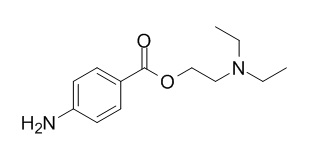Procaine
Procaine is a benzoic acid derivative with local anesthetic and antiarrhythmic properties. Procaine binds to and inhibits voltage-gated sodium channels, thereby inhibiting the ionic flux required for the initiation and conduction of impulses. It is a DNA-demethylating agent with growth-inhibitory effects in human cancer cells, it inhibits the Wnt canonical pathway by promoter demethylation of WIF-1 in lung cancer cells.
Inquire / Order:
manager@chemfaces.com
Technical Inquiries:
service@chemfaces.com
Tel:
+86-27-84237783
Fax:
+86-27-84254680
Address:
1 Building, No. 83, CheCheng Rd., Wuhan Economic and Technological Development Zone, Wuhan, Hubei 430056, PRC
Providing storage is as stated on the product vial and the vial is kept tightly sealed, the product can be stored for up to
24 months(2-8C).
Wherever possible, you should prepare and use solutions on the same day. However, if you need to make up stock solutions in advance, we recommend that you store the solution as aliquots in tightly sealed vials at -20C. Generally, these will be useable for up to two weeks. Before use, and prior to opening the vial we recommend that you allow your product to equilibrate to room temperature for at least 1 hour.
Need more advice on solubility, usage and handling? Please email to: service@chemfaces.com
The packaging of the product may have turned upside down during transportation, resulting in the natural compounds adhering to the neck or cap of the vial. take the vial out of its packaging and gently shake to let the compounds fall to the bottom of the vial. for liquid products, centrifuge at 200-500 RPM to gather the liquid at the bottom of the vial. try to avoid loss or contamination during handling.
J Insect Sci.2020, 20(5):18.
Korean Journal of Plant Resources2021, 34(1):52-58.
Antioxidants (Basel).2020, 9(6):544.
Fitoterapia.2018, 124:92-102
Pak J Pharm Sci.2023, 36(1):51-57.
BMC Biotechnol.2024, 24(1):94.
Biomedicines.2024, 12(3):495.
Int J Mol Sci.2021, 22(21):11836.
J.the Korean Socie. Food Sci.&Nut.2023; 52(1):26-39.
Front Microbiol.2019, 10:2806
Related and Featured Products
Cancer Res. 2003 Aug 15;63(16):4984-9.
Procaine is a DNA-demethylating agent with growth-inhibitory effects in human cancer cells.[Pubmed:
12941824]
Methylation-associated silencing of tumor suppressor genes is recognized as being a molecular hallmark of human cancer. Unlike genetic alterations, changes in DNA methylation are potentially reversible. This possibility has attracted considerable attention from a therapeutics standpoint. Nucleoside-analogue inhibitors of DNA methyltransferases, such as 5-aza-2'-deoxycytidine, are able to demethylate DNA and restore silenced gene expression. Unfortunately, the clinical utility of these compounds has not yet been fully realized, mainly because of their side effects. A few non-nucleoside inhibitors of DNA methyltransferases have been reported, including the anti-arrhythmia drug procainamide. Following this need to find new demethylating agents, we have tested the potential use of Procaine, an anesthetic drug related to procainamide.
METHODS AND RESULTS:
Using the MCF-7 breast cancer cell line, we have found that Procaine is a DNA-demethylating agent that produces a 40% reduction in 5-methylcytosine DNA content as determined by high-performance capillary electrophoresis or total DNA enzyme digestion. Procaine can also demethylate densely hypermethylated CpG islands, such as those located in the promoter region of the RAR beta 2 gene, restoring gene expression of epigenetically silenced genes. This property may be explained by our finding that Procaine binds to CpG-enriched DNA. Finally, Procaine also has growth-inhibitory effects in these cancer cells, causing mitotic arrest.
CONCLUSIONS:
Thus, Procaine is a promising candidate agent for future cancer therapies based on epigenetics.
Anesth Analg. 2003 Jul;97(1):85-90,
Procaine and mepivacaine have less toxicity in vitro than other clinically used local anesthetics.[Pubmed:
12818948]
The neurotoxicity of local anesthetics can be demonstrated in vitro by the collapse of growth cones and neurites in cultured neurons. We compared the neurotoxicity of Procaine, mepivacaine, ropivacaine, bupivacaine, lidocaine, tetracaine, and dibucaine by using cultured neurons from the freshwater snail Lymnaea stagnalis. A solution of local anesthetics was added to the culture dish to make final concentrations ranging from 1 x 10(-6) to 2 x 10(-2) M. Morphological changes in the growth cones and neurites were observed and graded 1 (moderate) or 2 (severe). The median concentrations yielding a score of 1 were 5 x 10(-4) M for Procaine, 5 x 10(-4) M for mepivacaine, 2 x 10(-4) M for ropivacaine, 2 x 10(-4) M for bupivacaine, 1 x 10(-4) M for lidocaine, 5 x 10(-5) M for tetracaine, and 2 x 10(-5) M for dibucaine. Statistically significant differences (P < 0.05) were observed between mepivacaine and ropivacaine, bupivacaine and lidocaine, lidocaine and tetracaine, and tetracaine and dibucaine. The order of neurotoxicity was Procaine = mepivacaine < ropivacaine = bupivacaine < lidocaine < tetracaine < dibucaine. Although lidocaine is more toxic than bupivacaine and ropivacaine, mepivacaine, which has a similar pharmacological effect to lidocaine, has the least-adverse effects on cone growth among clinically used local anesthetics.
Oncol Rep. 2009 Dec;22(6):1479-84.
Procaine and procainamide inhibit the Wnt canonical pathway by promoter demethylation of WIF-1 in lung cancer cells.[Pubmed:
19885602]
Secreted Wingless type (Wnt) ligands have previously been shown to be involved in tumor developmental processes and oncogenesis. Aberrant promoter methylation of Wnt inhibitory factor-1 (WIF-1) is a fundamental mechanism of epigenetic silencing in human cancers. Procaine, a local anesthetic drug, and procainamide, a drug for the treatment of cardiac arrhythmias, have been reported as inhibitors of DNA methylation, causing demethylation and reactivation of methylation-silenced genes such as RARbeta and GSTP1. The promoter demethylation of WIF-1 has not previously been reported on. We demonstrated previously that WIF-1 is silenced due to promoter hypermethylation in lung cancer cell lines.
METHODS AND RESULTS:
In this study, we demonstrate promoter demethylation of WIF-1; restoration of WIF-1 expression, and underexpression of cytosolic beta-catenin protein and TCF reporter activity, after Procaine and procainamide treatment in H460 and A549 cell lines. Our results provide the first evidence that Procaine and procainamide reactivate WIF-1 in these cancer cells and downregulate the Wnt canonical pathway.
CONCLUSIONS:
These results further suggest that Procaine and procainamide may have a potential use for preventing the development of lung cancer.



